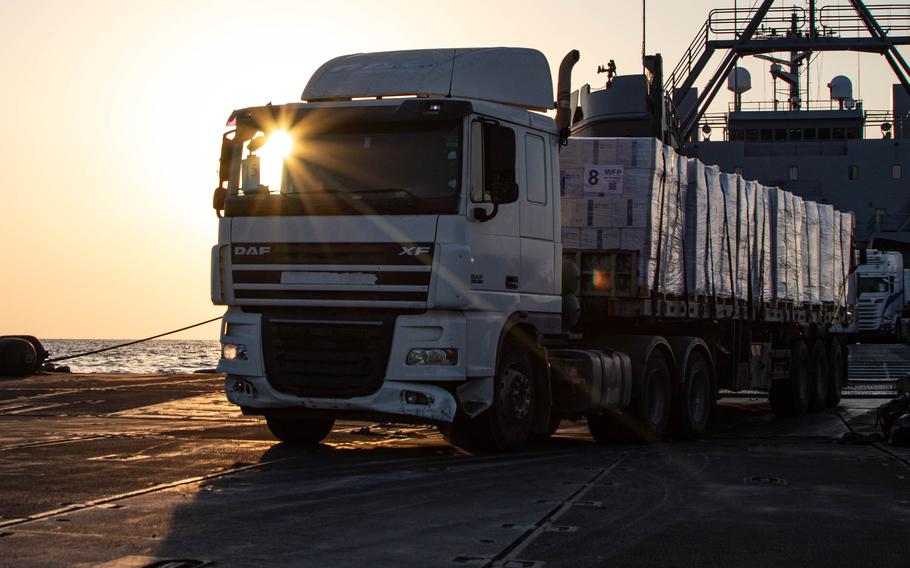
A truck transports humanitarian aid from the U.S.-built pier onto the beach in Gaza on June 22, 2024. (Malcolm Cohens-Ashley/U.S. Army)
WASHINGTON — The military equipment and troops deployed to operate a floating pier off the coast of Gaza to help provide humanitarian aid to the war-torn enclave are expected to return to the U.S. by the middle of September, the Pentagon said Thursday.
About 1,000 soldiers and sailors were involved in the short-lived operation. Pentagon spokeswoman Sabrina Singh said 235 soldiers had already returned to Joint Base Langley-Eustis, Va., earlier this month, and 209 troops returned last week to Naval Air Station North Island, Calif. Another 100 soldiers will return to Langley-Eustis in the coming days, according to a defense official who spoke on condition of anonymity.
The floating pier — known as Joint Logistics Over-the-Shore, or JLOTS — was meant to provide another way to deliver needed aid into Gaza. Health officials have warned for months that millions of Gazans face extreme hunger as Israel continues its war against the Hamas militants who launched a surprise assault in October from the enclave.
The JLOTS operation was first announced March 7 during President Joe Biden’s State of the Union address. The following day, Air Force Maj. Gen. Pat Ryder, the top Pentagon spokesman, said the temporary pier would be operational within about 60 days.
The use of the pier ended July 17 after about 20 days of operational use, military officials said at the time, after poor weather conditions and concerns about onshore security plagued the operation.
The pier became operational May 17, but the Pentagon announced less than two weeks later that it would be removed for repairs after suffering damage from rough seas and bad weather. It became operational again June 7.
Vice Adm. Brad Cooper, deputy commander of U.S. Central Command, which oversees military operations in the Middle East, told reporters at the time that the issue with the pier was “solely from unanticipated weather.”
A week later, CENTCOM again announced the pier was being temporarily removed due to high seas. It was reattached June 19 before being removed for the final time and taken to the port of Ashdod in Israel.
Security concerns also disrupted the distribution of aid. The United Nations suspended deliveries from the pier on June 9, a day after the Israeli military used the area around it for airlifts after a hostage rescue that killed more than 270 Palestinians. U.S. and Israeli officials said no part of the pier was used in the raid. However, U.N. officials said any perception in Gaza that the project was used might endanger aid work, the Associated Press reported.
As a result, aid transported onto the beach using the pier piled up. The World Food Program hired a contractor to move the aid from the beach to prevent the food and other supplies from spoiling, according to the AP.
The Pentagon originally determined the pier would cost $320 million, but defense officials later dropped the estimate to about $230 million. Singh at the time said lower-than-expected costs for contracted trucks, drivers and commercial vessels and the United Kingdom’s contribution of a vessel lowered the U.S. price tag by about $90 million.
Cooper has said the military expects to save another $20 million, but he did not say from where the reduction would come.